The 2015 MacBook Review
by Ryan Smith on April 14, 2015 10:15 AM ESTThe MacBook’s Retina Display: Pro Quality
One of the long-standing demands for Apple’s MacBook Air line has been for an IPS, Retina-density display for Apple’s light laptops. After introducing Retina-style displays on the MacBook Pro, iPad, iPhone, and iMac, the Air was the last product without a Retina display. However at the same time the Air was also simultaneously Apple’s entry-level laptop and their ultra-portable laptop, so adding a Retina display to the Air has always faced the needs of balancing cost and technical considerations against consumer demand.
As it turns out the Air isn’t getting a Retina display (at least not this year), but Apple is going all-in on the more premium MacBook, Retina display, integrated cover glass, and all. From a cost perspective this isn’t all that surprising, but from a technical perspective it means Apple has needed to address the technical cost of going Retina.
Starting from the top, the MacBook ships with a 12” IPS Retina display. The display’s native resolution is an uncommon 2304 x 1440, which is essentially a 16:10 version of the more common 16:9 1440p. With Apple essentially going pro on the MacBook, I’m happy to see a 16:10 display in what’s now Apple’s smallest notebook, increasing the effective size of the display while giving it a more squared design that increases the amount of vertical real-estate versus what a 16:9 display would offer.
The MacBook’s display ends up being 64.72in^2 in size, roughly 13% larger than the MacBook Air 11”. This comes despite the fact that the MacBook occupies a smaller overall footprint than the MBA 11”, showcasing how Apple has been able to increase the screen size while bringing down the overall laptop size. Some of this is ultimately due to geometry from the different aspect ratio, but also Apple has been able to reduce the size of the bezel surrounding the panel, making the panel a larger percentage of the total lid. The MacBook still isn’t something that most people would qualify as an ultra-thin bezel, but coming from the relatively thick MacBook Air it’s quite the change.
Given the display’s native resolution of 2304 x 1440 contained in a 12” panel, this puts the pixel density of the display at 226 PPI, which is virtually identical to the 226 PPI rMBP13 and 220 PPI rMBP15, giving it same density as Apple’s other Retina laptops. Functionally speaking I’d argue that users are going to have their heads a bit closer to the 12” MacBook than they would a larger rMBP, so the effective density is likely still in the rMBP’s favor, but in terms of construction they’re all very similar.
Meanwhile Apple isn’t going into too much detail on the panel other than its size and driving technology (IPS), but they did tell us that the pixels in this panel were designed to have a wider aperture to allow more light out, helping to offset the higher power costs of lighting a Retina display. To that end Apple says that the MacBook’s display is 30% more energy efficient than any other Mac notebook at an equivalent brightness. At this point we’re still trying to identify the panel supplier, as Apple’s tools have not been very forthcoming. A Sharp IGZO panel would traditionally be a good choice for such a power-constrained device, but it’s entirely possible Apple is going with long-time partner LG as well.
Though regardless of the supplier and aperture improvements, as we’ll see in our battery life benchmarks Apple is clearly still having to devote quite a bit of power towards lighting this screen. Thankfully for Apple however just as with the rMBPs, iPhone, and iPad, this is a one-off cost that they don’t have to pay in future generations.
Moving on, as a Retina display Apple offers a range of scaled (virtual) resolutions, with the MacBook’s default resolution serving as a HiDPI version of 1280 x 800. The fact that the scaled resolution is not exactly one-quarter of the display’s physical resolution is an unusual first for an Apple device, but considering the size of the display and power requirements, not to mention the similar PPIs to the rMBPs, I suspect 1280 x 800 scaled on a 2304 x 1440 display was a tradeoff. In any case even without perfect 2:1 scaling Retina-enabled applications look great, and now nearly 3 years after started on Retina in the OS X ecosystem, the number of applications without Retina support are thankfully miniscule.
As far as desktop performance goes, we haven’t found any major problems for the MacBook’s Intel HD Graphics 5300 GPU. Even with Core M’s power limits it doesn’t show any issues holding 60fps at the default virtual resolution of 1280 x 800, though I would not suggest going any higher unless it’s necessary.
Finally, let’s take a look at the MacBook’s display by the numbers. From a design perspective Apple is shipping a pro-quality display, but does the out of the box performance match up with Apple’s high standards?
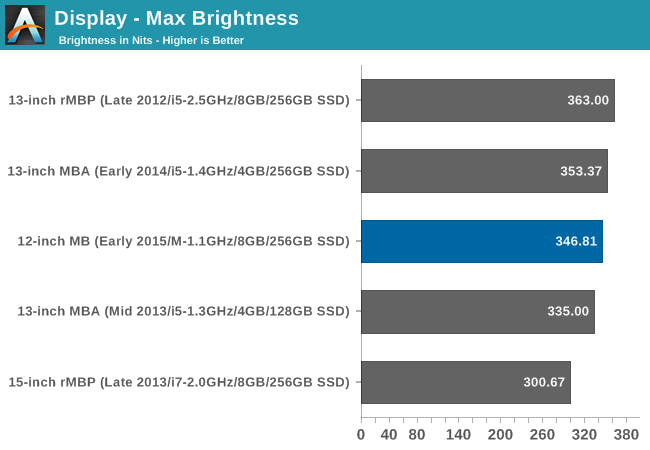
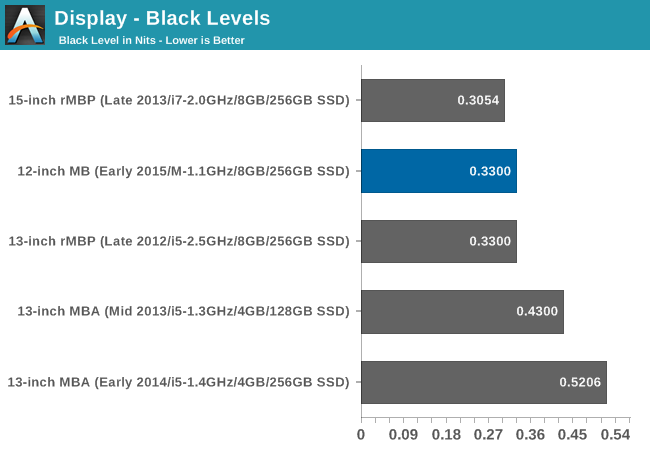
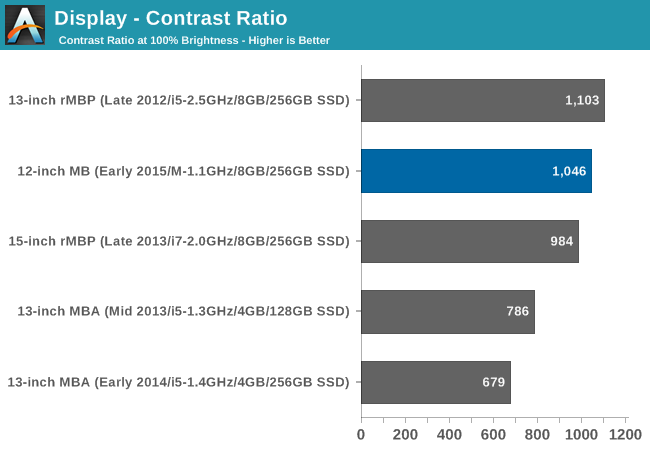
Compared to our most recent MacBooks, the 2015 MacBook delivers contrast performance similar to the Retina MacBook Pros, which is not all that surprising given the shared pixel densities and use of IPS panels among all of these products. Somewhat surprisingly, even with the MacBook’s more limited battery capacity Apple allows the max brightness to go up to 346 nits, in-line with the better-fed rMBPs. At this max brightness setting the black levels work out to 0.33, identical to the 2012 rMBP13. Overall Apple’s black levels tend to be better than average but not fantastic, and the MacBook doesn’t change this.
Otherwise this puts the final contrast ratio at 1046. This is fairly common for HiDPI IPS displays, and though it isn’t chart-topping it’s again right in line with what other Apple laptops do.
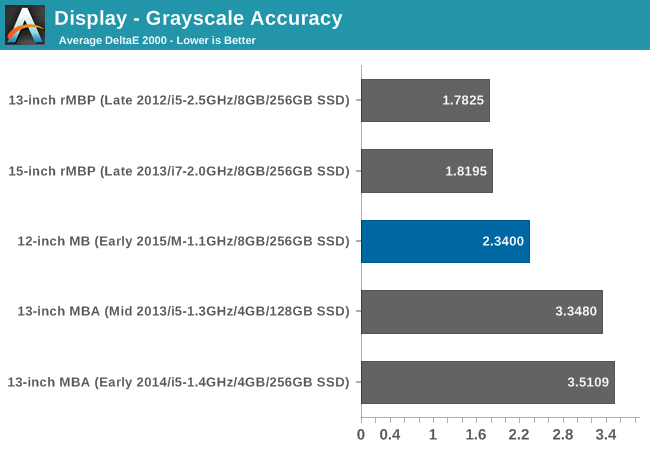
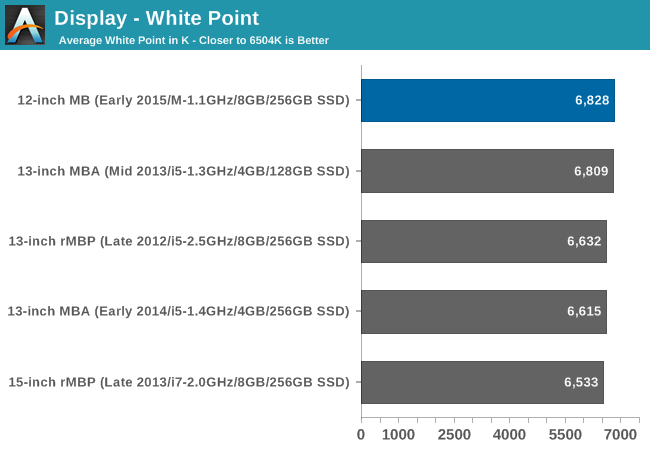
Moving on to accuracy measurements, the MacBook’s greyscale accuracy can’t quite touch the rMBPs, but otherwise at an error of just 2.34 it’s still among the best laptop displays. Even among great PC laptops, out of the box performance below 3 is exceptionally rare.
On the other hand the MacBook’s white point is not quite as good as we’d like to see, and not as good as what the rMBPs can do. The goal here is 6504; the MacBook hits 6828, reflecting the fact that it’s just a bit too red and just a bit too light on blue.
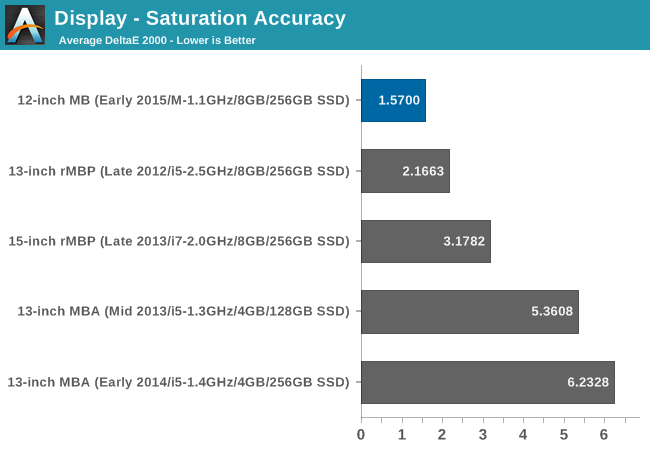
Meanwhile the MacBook’s color saturation accuracy is nothing short of amazing. Here it beats even the rMBPs, not to mention easily surpassing the MBAs and their TN displays. Even though it’s a bit too red, the MacBook is close enough for great out of the box performance.
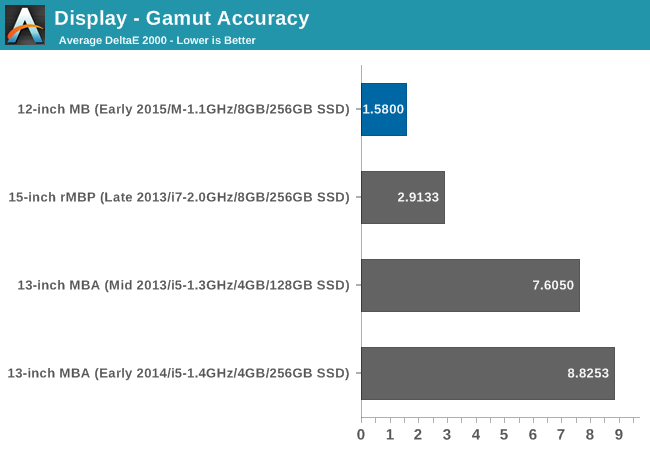
Similar to saturation accuracy, gamut accuracy is well in the MacBook’s favor. Once again even the rMBP we have on file is well behind, never mind the MBAs.
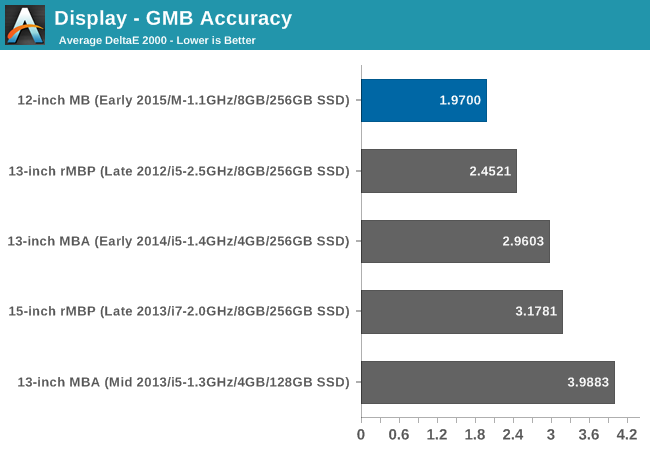
Finally, the GMB color checker results continue to be well in the MacBook’s favor. The error of 1.97 is once more better than any other Mac we have tested, and overall a great place to be at, especially for out of the box performance. Overall this reiterates the fact that while the MacBook may not be classified as a Pro, it without a doubt packs a Pro display.
With post calibration it’s almost certain we could get the errors on the MacBook down to below 1.0. But with such great out of the box performance it’s difficult to complain. Other than for color-critical work, this is a near-perfect reproduction of the sRGB color space.


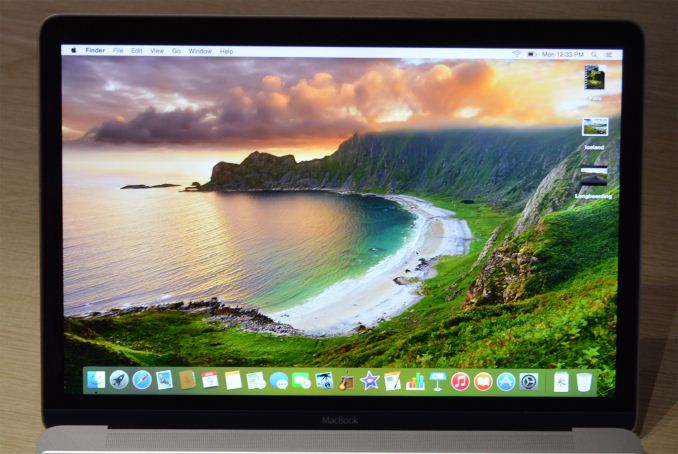
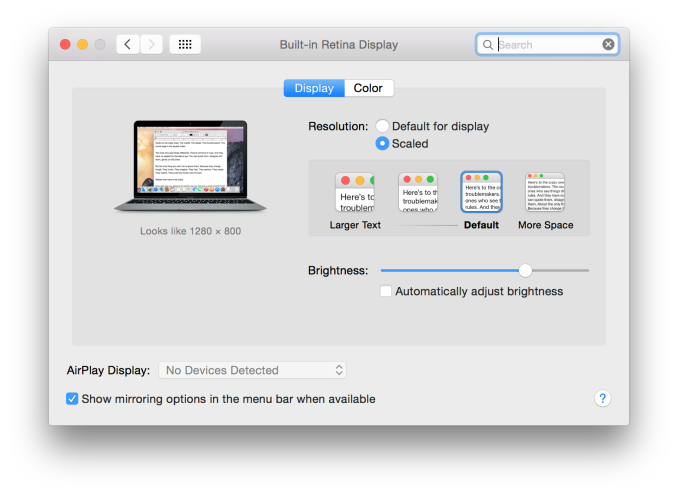
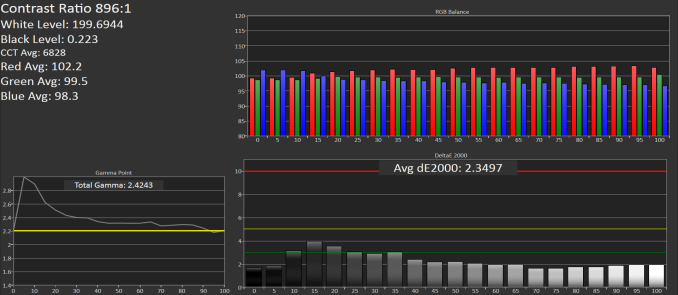
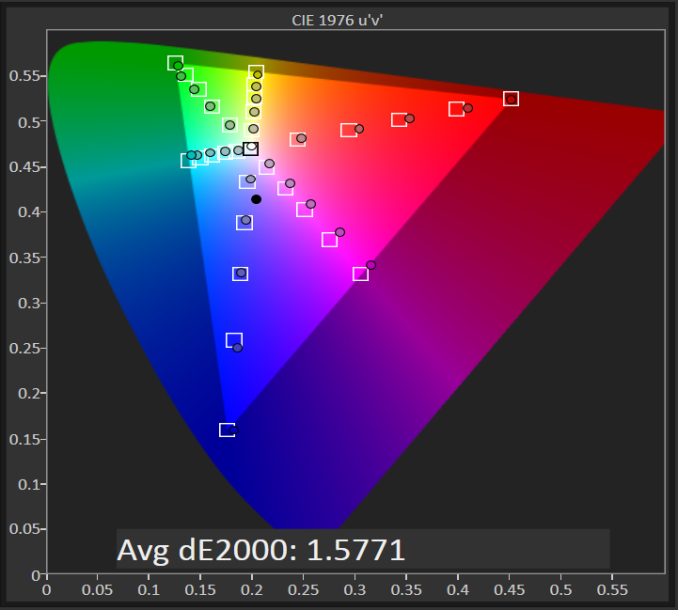










354 Comments
View All Comments
darkich - Wednesday, April 15, 2015 - link
Oh Anandtech, it is blatantly obvious that you do everything you can to twist reality in favor of your sponsor (Intel).So MacBook has a twice better GPU than iPad Air 2?
Why didn't you used a *graphics* category to explain that fact?
Why didn't you ran Manhattan or T Rex and showed the respective scores?
iLovefloss - Wednesday, April 15, 2015 - link
They linked to a more comprehensive Core M review in the article. If you actually read the damn thing rather than trying to accuse people of being sellouts, then you maybe you'd caught that.Shit, the only thing more annoying than a social media (anti-)SJ conversation is tech websites review comments. Everybody is a sellout.
narcaz - Wednesday, April 15, 2015 - link
I am sorry, but i think this one of the of the more mediocre reviews from Anandtech:"Compared to the 128GB SSD and 4GB of RAM in the base MacBook Airs, this is the first ultra-portable Mac in a while where I can say even the base model feels properly equipped. At the very least users shouldn’t be struggling with RAM or SSD capacity for some time. Meanwhile given the fact that the equivalent upgrade of an 11” MacBook air would be $300 – bringing the total price to $1199 – this means that while the MacBook is still more expensive than a MacBook Air, the difference isn’t nearly as wide as it would first seem."
Copy paste from Apple's marketing? The difference is as wide as it would first seem when you look at the trade-off. Compared to the MBA you get better portability and a retina screen. But you loose connectivity, battery life, hd camera, magsafe, cpu/gpu performance. And according to your defined target audience (second device buyers) buying these upgrades doesn't make much sense. It is ok that the 12'' MB is expensive, but don't try to argue around this fact.
"As far as desktop performance goes, we haven’t found any major problems for the MacBook’s Intel HD Graphics 5300 GPU. Even with Core M’s power limits it doesn’t show any issues holding 60fps at the default virtual resolution of 1280 x 800, though I would not suggest going any higher unless it’s necessary."
I had the impression that higher resolutions don't work very well on the 12'' MB models in the Apple store. It felt like the first 13'' rMBP: more screen space, but a bit laggy. The performance of the HD 4000 wasn't good enough and took another hit with Yosemite (especially when connected to a second display). I am not willing to invest in a MB, which isn't future proof for at least 2-3 years. The same is true for the potential lack of 4K/60hz. I hoped for more depth in this area.
The review could have been more critical about the 1 USB C Port. If it breaks you can't even charge your machine anymore and out of warranty services are extremely expensive. But i think the comments discussed this point to death. Thanks for the extra remarks about the sustained performance in the comments and please put this in the review and maybe do more tests.
wave84 - Wednesday, April 15, 2015 - link
I don't really think the Macbook is expensive. This is actually useable as a main computer for a lot of users (journalists, web designers, web programmers, etc). It will do just fine, as long as you have 8GB RAM and 256 for storage, which you get.You lose some stuff indeed, but for 100 bucks you get retina screen, extreme portability, and most important of all, it's fanless and completely silent. This is a huge quality of life improvement which no review will take into account.
Also, i do not believe the port to be an issue. Either you are docked, so you have plenty of ports (and you only unplug one cable), either you are mobile, when one port is enough for 99% of use cases.
I am very close to buying it. Still waiting for some upgraded CPU numbers.
narcaz - Wednesday, April 15, 2015 - link
I am looking for a second device besides my 15'' rMBP. The iPad doesn't cut it anymore. But 1279$ + 79$ (needed for occasional presentation) is expensive compared to the 11'' MBA 899$+29$. Impossible to sugarcoat it. It looks like Apple's upselling strategy got you on the hook. You can rationalize this purchase as much as you want, but i don't want to pay for upgrades, which i don't need. If you value portability and retina screen fine, enjoy it, but this doesn't make it a very good deal.Even in the Apple ecosystem the single port is problematic. Airplay Screen Mirroring suffers from lags, iCloud Photo Library is cumbersome and there is no backup solution while being on the road. Cables aren't dead. I think the next version will have second port.
telsin - Wednesday, April 15, 2015 - link
I'm curious to see if a newer hardware revision of the Apple TV that they're likely to announce at WWDC resolves some of the airplay lag. That thing is still using an A5 processor, whereas the latest iphones are up to A8 (huge difference in CPU/GPU performance). I too found airplay rather obnoxious when I tried it. In OSX, you can have it treat an airplay target as a second monitor, but it really kind of sucks unless you're just putting something there to read as a static document.bogda - Wednesday, April 15, 2015 - link
Now, make MacBook Air with the same quality screen, smaller bezel (like on this MacBook) and keyboard that stretches from edge to edge (like on this MacBook) and I might actually switch from PC to Mac.Mushin - Wednesday, April 15, 2015 - link
As for the SSD which is only connected through PCIe 2.0 that is a limitation of Core M see:http://ark.intel.com/products/84666/Intel-Core-M-5...
cknobman - Wednesday, April 15, 2015 - link
All I can say is ehh.Sure its built nice and a super small form factor
BUT
Price is high, performance is just OK, and battery life is frankly underwhelming. Sure the battery life is not terrible but given the hype over the Core M I was expecting better battery life.
Still no touch screen and it is still confined to the limitations of a laptop.
The benefit of small underpowered devices like this should lie in their ability to serve multiple purposes easily and change form factors.
If I still have to use it like a laptop (IE: open it up, type on a keyboard) and pay such a high price then I may as well go get a laptop with more power and better battery life.
For this price I'd still rather have something like a Surface Pro 3. With its ability to serve multiple purposes I can use it like a tablet or a laptop, get better battery life, and get a touch screen. All while paying less.
nerd1 - Wednesday, April 15, 2015 - link
Sp3 is lighter, thinner, more powerful, has more ports, has more input methods and even cheaper.